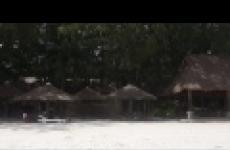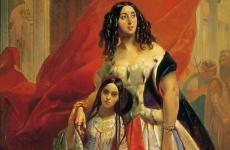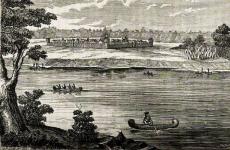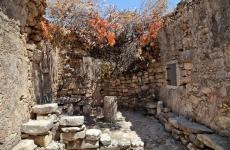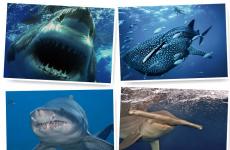Elagin Palace. Elagin Island Why is Elagin Island called that?
Elagin Island can rightfully be called a St. Petersburg oasis: this is where you can escape from the bustle of the city and relax and enjoy the harmony of nature. Meanwhile, this island is remarkable not only for this: this place has a truly amazing history, in which there was a place not only for facts, but also for legends.
Fact No. 1: The island was originally called Mishin
On old Finnish and Swedish maps the island was called Mistula-saari, which means "Bear Island". According to one version, it received such an affectionate name by analogy with other islands: Zayachiy, Losiny (now Vasilyevsky), Voronyy (now Aptekarsky), Koshachy (now Kanonersky) and others.
There is a legend that the island became Mishin with the light hand of Russian soldiers. So, according to legend, on one of the May nights of 1703, a small detachment of Preobrazhensky residents landed on one of the islands of the Neva delta. Making their way through the swampy forest, the soldiers suddenly heard a crash. Suspecting a Swede's trap, they stopped and put their guns on the butt. Suddenly, from behind a fallen tree, the figure of a large gray bear rose up with a roar. “Ugh, you abyss, we thought we’d see a Swede, but ran into a bear, which means this island is not Swedish, but Mishkin,” one of the soldiers commented on the unexpected meeting.
Fact No. 2: Evening festivities were popular on the spit of the island in the 19th century

St. Petersburg residents especially liked the western tip of Elagin Island - the so-called arrow. Such an unexpected choice of vacation spot is associated with the name of one of the St. Petersburg beauties - Countess Yulia Pavlovna Samoilova. In St. Petersburg she was called the queen of salons, she had a relationship with the famous artist Karl Bryullov, and Alexander Sergeevich Pushkin himself wrote the following enthusiastic lines about her: “She has no rivals, no friends, our pale circle of beauties disappears in her radiance...”.
The young countess was the mistress of a family country estate near St. Petersburg, not far from Tsarskoe Selo - Grafskaya Slavyanka - all of St. Petersburg came to the receptions that she hosted here. According to legend, Nicholas I was extremely annoyed by the popularity of the young beauty, so he resorted to a trick: the emperor offered to sell him the Count’s Slavyanka. Countess Samoilova could not ignore the sovereign’s proposal, which sounded like an order, however, according to legend, she made it clear that she saw through his plan, asking him to tell the emperor that “we did not go to Slavyanka, but to Countess Samoilova, and, wherever she was, will continue to visit her.”
The next day, the beauty, accompanied by her closest admirers, came to the then deserted spit of Elagin Island and allegedly said: “This is where they will come to see Countess Samoilova.” And she turned out, in fact, to be right: after a short time, the arrow became a favorite place for evening festivities of the St. Petersburg nobility.
Fact No. 3: Under Elagin, the island acquired its name

Before the director of the court theater I.P. Elagin, the island belonged to different people: diplomat P.P. Shafirov, Prosecutor General P.Ya. Yaguzhinsky, Senator A.P. Melgunov. It is known that after the latter was appointed governor-general of Yaroslavl, he sold the estate to Prince G.A. Potemkin for 9 thousand rubles. But it was Elagin who truly transformed the island - a stone palace with greenhouses, gazebos, pavilions and service premises was built, and the garden, laid out under Melgunov, became public. The island itself has since become known as Elagin.
This is how one of Ivan Perfilyevich’s contemporaries recalled this time: “Due to the hospitality of the famous owner of the cheerful island, it can be considered a public garden, since all well-dressed people are not forbidden to walk throughout the summer. In addition, everyone who came for a walk, even in the absence of the owner, was received by the butler and treated, depending on the time, to lunch or dinner.”
Fact No. 4: Elagin Palace is the first serious creation of Karl Rossi

After the death of I.P. Elagin in 1796, the estate changed owners more than once - finally, by 1817, the mother of Emperor Alexander I, Maria Feodorovna, became its official owner. The very next year, work began on the island to rebuild the palace; the court architect Carl Rossi was appointed their leader.
As a result, only strong outer walls remained of Elagin’s former house. In parallel with the Rossi Palace, a granite pier, a pavilion with a flagpole, and a kitchen building were created, which was connected to the palace by a special underground passage for serving dishes. Stables were located nearby, and a project was also developed to create a park in the English style. Thus, this large-scale work by Carl Rossi on Elagin Island became his first unified architectural ensemble.
Fact No. 5: Elagin Palace was sometimes called the “palace of doors”

The palace received such a funny nickname due to the truly huge number of doors it has - and it is absolutely impossible to find at least two identical ones. In addition, Carl Rossi created several false doors for symmetry. By the way, this was not the only thing that the famous architect took care of: all the furniture, including even the most insignificant interior details, was made according to his drawings.
Fact No. 6: Central Park of Culture and Culture is a favorite vacation spot for Leningraders

In 1932, one of the first Soviet recreation and entertainment centers for workers was opened on Elagin Island - the Central Park of Culture and Recreation, or CPKiO for short. It was decorated with various Soviet symbols: sculptural images of athletic girls, valiant young men in army uniforms and pioneers with traditional ties around their necks - the best creative forces of Leningrad worked on their images. The new park was so loved by the townspeople that it received an affectionate informal name – “Chickie”.
Elagin Island is a protected natural complex located in the very north of the mouth of the Neva. Today, the island is a rapidly developing space, offering numerous cultural leisure options for vacationers of any age.
Elaginoostrovsky Palace

Initially, Elagin Island was the residence of high-ranking persons. During the creation of a new city on the Neva, Peter I tried to improve the maximum number of territories, and those lands that he could not cover alone were given to his closest associates.
A similar fate befell Elagin Island. Its first owner was a prominent statesman of the early 18th century, P. P. Shafirov. In total, in one century, nine owners of the island changed, and it received its modern name after the fifth owner - I.P. Elagin.
The main decoration of the island is, undoubtedly, the Elaginoostrovsky Palace Museum, which was built in 1818-22 as a summer royal residence, and until 1917 was the property of the imperial family.

During the Soviet era, the palace acquired museum functions, and an exhibition dedicated to history and everyday life was opened within its walls. However, from 1930 to 1987, the museum’s activities were suspended due to the ruin and subsequent destruction of the Elaginoostrovsky Palace during the Great Patriotic War.
Only in 1987 did the creation of a new museum collection begin. Now visitors to the Elaginoostrovsky Palace have the opportunity to see works of art from the early 19th century and appreciate the Russian residential interior of the late 19th – early 20th centuries.
Elagin Island is one of the best leisure spots in St. Petersburg, where all the necessary conditions have been created to relax your soul and body. You can visit one of the fascinating exhibitions or play sports in the fresh air.
Central Park of Culture and Culture named after Kirov

When St. Petersburg residents say “Elagin Island,” in most cases it is the Central Park of Culture and Culture that is meant. The park opened in 1932, and since then it has become a favorite vacation spot for Leningrad residents.
Today, none of the parks in St. Petersburg can compare with the Central Park in popularity. Elagin Park daily attracts guests and residents of the city, offering a large number of leisure options, including:
- outdoor training - comfortable conditions have been created for athletes in the park, and on Saturdays classes are conducted by professional trainers;
- musical concerts of emerging and established artists, poetry evenings and meetings with prominent St. Petersburg cultural figures;
- costume balls for the whole family in the style of the 19th century;
- “Creative Dacha” - all kinds of master classes for children and adults are held here;
- relax in one of the cozy cafes;
- a children's playground for the youngest park visitors;
- feeding squirrels - in the alleys of the Central Park of Culture and Culture named after. In Kirov you can meet many squirrels who are not averse to eating nuts from the hands of visitors.
Museum of Art Glass

This museum is the only such institution in St. Petersburg and belongs to the structure of the palace museum on Elagin Island. The museum fund is made up of a huge collection of domestic art glass, most of which once belonged to the Leningrad plant.
In total, the museum, which is located in the Orangery building, currently has about 700 exhibits made of crystal and glass. In addition to the permanent exhibition, master classes on glass painting and thematic presentations are organized here.
Elagin Island is open to the public every day from 6 a.m. In summer, the park is open until midnight, and in winter - until 23 hours.
Petrogradsky district is a great place to relax. This is one of the oldest districts of St. Petersburg. Here you will find many historical monuments, noisy avenues and quiet streets, parks and squares. If you decide to relax in St. Petersburg, an excellent solution would be to rent an apartment on Petrogradskaya.
Today we will tell you the story of one of the most picturesque places in St. Petersburg - Elagin Island.
XVIII century
Creating the new capital of the Russian Empire on the banks of the Neva, Peter I sought to develop the surrounding territories, distributing them to his comrades. The first owner of the island in 1709 was the vice-chancellor Baron Pyotr Pavlovich Shafirov (1669–1739), a famous diplomat and statesman. During the 18th century, the island had nine noble owners. During this time, it was renamed several times. Its original name was “Mistula-saari” in Finnish. Then the island was called Mishin or Mikhailin. According to legend, a patrol of Russian soldiers encountered a large bear here. The island received its current name in honor of the fifth owner - Ivan Perfilyevich Elagin, chief chamberlain of the imperial court.
19th century
By the beginning of the 19th century, maintaining a large estate located on Elagin Island became too expensive, and the last owner of the island, Grigory Vladimirovich Orlov, sold it in 1817 to the treasury for three hundred and fifty thousand rubles.
From this time on, a new stage in the life of Elagin Island begins. For the next hundred years it comes into the possession of the Russian imperial house. In 1818, by decree of Emperor Alexander I, “a committee was formed to rebuild the former Elagin Palace, build kitchen and stable buildings, remodel a large stone greenhouse and other things on Elagin Island.”
K. Rossi was appointed chief architect of the construction. He had to rebuild the palace, create new service buildings and equip the island for the summer stay of the Dowager Empress Maria Feodorovna. The architect did not limit himself to just rebuilding the palace and office premises, but transformed the entire island.
Rossi had to carry out construction work, and the improvement of the island and the redevelopment of the park were entrusted to the experienced gardener Joseph Bush Jr., famous for the creation of Pavlovsky and Tsarskoye Selo parks. The master plan of the palace ensemble on Elagin Island, which consistently implements the principle of a landscape park with its asymmetry and picturesqueness, was developed jointly by Rossi and Bush. Through their efforts, the island, “with great difficulty torn out of the swampy soil of St. Petersburg, was turned into the Isola bella of the Russian North - a “beautiful island”, and the park on it - into one of the most beautiful parks in Europe.
During two construction seasons, 1818 and 1819, the palace was rebuilt. The date of completion of construction and finishing work, as well as interior decoration, is considered to be 1822.
For a hundred years, the island remained in the possession of the Romanovs and was a favorite vacation spot for the imperial family. Over the years, the Elaginoostrovsky Palace has developed a unique collection, the basis of which was laid by works originally designed by the great architect, master of interior design and decorative arts, Carl Rossi.
XX century
By decision of the Central Committee of the All-Union Communist Party of Bolsheviks and the Council of People's Commissars of the USSR dated December 2, 1931, the TsPKO park was opened on Elagin Island. The opening of the folder took place on August 5, 1932.
After the death of S. M. Kirov in 1934, Krestovsky, Elagin and Kamenny Islands were renamed Kirov Islands, and the Central Park of Culture and Recreation was named after S. M. Kirov. Numerous sports grounds and attractions are being created on the island.
On Elagin Island there is the Elagin (Elaginsky) Palace, which today is the architectural core of the Central City Park of Culture and Recreation; During the tsarist period, the palace was the basis of the composition of a vast and picturesque country estate. Its owners were at the end of the 18th century. Obergoffmeister of Catherine II I.P. Elagin (since the 1770s, the owner of the island, which eventually began to be called by his name) and almost from the beginning of the 19th century. Dowager Empress Maria Feodorovna (widow of Emperor Paul I). By order of Elagin, a palace was erected on the island in the 1780s (architect D. Quarenghi), a park was laid out, ponds and canals were dug, bridges and pavilions were built. The park became one of the most favorite places for walks of the St. Petersburg nobility. In 1817, the imperial family became the owner of the island. At first, they were going to rebuild the Elagin mansion and turn it into the palace of Emperor Alexander I. And when the island became the property of his mother, Dowager Empress Maria Feodorovna, according to her order, the architect K. Rossi created it on it in 1818-1822. a magnificent ensemble in the style of classicism. The finishing and decoration of the premises of the Rossi Palace were carried out by the best sculptors, painters, and master decorators of that time: V.I. Demut-Malinovsky, S.S. Pimenov, D. Scotti, A. Vigi, B. Medici and others. The converted Elagin Palace became the summer residence of Maria Feodorovna. At the same time, the island was still called Elagin, like the palace.
Gradually, Elagin Island became known as one of the centers of Russian Freemasonry. Meetings of the Freemasons were held in the Rotunda pavilion (Pavilion under the Flag), which was part of the Elagin Palace complex.
Soon after 1917, the Historical and Household Museum was opened in the nationalized palace. In 1932, the Central Park of Culture and Recreation was created on Elagin Island; It remains a recreational and entertainment center now, but this place is more often called, as in the past, “Islands.” The palace houses the Museum of Russian Decorative and Applied Art and Interior of the late 18th - early 20th centuries. (The Blue and Crimson Drawing Rooms and the Oval Hall, restored by restorers, are especially good).
The buildings of this palace complex suffered greatly during the Great Patriotic War. In the post-war period, restorers restored the composition of the facades and decoration of the palace interiors. The center of the palace complex is the palace, fenced with an openwork cast-iron lattice. The palace has differently designed front facades. The facade facing the garden is decorated with a six-column portico (with columns of the Corinthian order) under a pediment and a ramp with cast iron lions (these lions, cast at the St. Petersburg State Foundry at the end of the 18th century, are copies of the lions from the Piazza della Signoria in Florence; they were the first cast iron lions in St. Petersburg). Facade with columns facing the river. Middle Nevka, has special features due to the oval, protruding double-height hall. The complex of palace buildings also includes the Stable and Kitchen buildings, the Greenhouse, the Music Pavilion, the Pavilion with a granite pier, the Guardhouse, etc. All buildings are located among the greenery of the park freely, without a strict system, which emphasizes the picturesque overall composition of the island, designed by the best garden master of the first quarter XIX century D. Bush. According to the project of K. Rossi and D. Bush, an extensive landscape park was created around the palace.
Since the 1770s, Elagin was the owner of the island, which eventually received his name. By this time he was already an influential and wealthy man, he loved life and could afford all its joys. On the island, in his luxurious house with a winter garden and a rich cellar of rare wines, Elagin lived cheerfully, loved guests, organizing parties and balls, the company of young and beautiful women, for whom he always had an insurmountable weakness until old age (his passion for women made him funny and eternal object of secular gossip). He was married to N.A. Ratikova, had two daughters. He spent the last years of his life away from the court, devoting almost all his time to his literary and historical works. His historical works are of some interest, but he too often failed to soberly and critically evaluate historical events and personalities. He died at the age of 68.
After Elagin, the preservation of the attractiveness of Elagin Island with the palace was facilitated by Empress Maria Feodorovna (1759-1828), the wife (from 1776) of Emperor Paul I, who left a good memory of herself in Russia. At the age of 17, she became the second wife of the 22-year-old cuckolded widower and heir to the Russian throne, Tsarevich Paul. After the death of Catherine II, Maria Fedorovna became, at the age of 37, the wife of the reigning 42-year-old Emperor Paul. During a quarter of a century of their married life, she was the wife of Emperor Paul I for only 5 years; in 1801, he was killed at the age of 47. They had 4 sons and 6 daughters. Then for 27 years she was the Dowager Empress, who saw her two sons (Alexander I and, after his death, Nicholas I) as Russian emperors. Being the mother of 10 children, whom she loved very much, she was largely removed from their upbringing (especially her sons), since these concerns were taken upon by the royal grandmother - her mother-in-law, Empress Catherine II. Pavel was removed from participation in government affairs and received limited funds for his “Small Court”. A rather secluded life in Pavlovsk and Totchina in conditions of limited funds marked the beginning of Maria Fedorovna’s economic activity and her close acquaintance with the life of the lower classes of the population. She always found and allocated tangible funds for charity and helping those in need.
Over the years of marriage, she was able to learn patience and forbearance towards the many shortcomings of her husband, who had a difficult, suspicious character. There was little joy in the family life of Maria Fedorovna, given the character of her husband, financial restrictions, and the death of their 5 children during her lifetime. Maria Feodorovna had the wisdom to find a common language with her husband’s close friend, maid of honor E.I. Nelidova (1758-1839), moreover, to make friends with her.
Empress Maria Feodorovna was the wife of Paul I for 25 years (of which 22 years she performed all marital duties, during 1776-1798 she gave birth to 10 children, in 1798 doctors forbade her to give birth because of the threat to her life from the next possible birth, which meant then the termination of her close relationship with her husband). She was the first empress in Russia to be crowned together with her husband, and therefore believed that after his violent death it was she who should have become the first person in the state (but this was contrary to the law adopted by Paul in 1797), but she could not. She accused the son of Alexander I, the new Emperor of Russia, of connivance in the murder of his father and her husband, made him understand that her nobility and moral superiority over him forced her to allegedly voluntarily cede his rights to the throne, and reminded him of the inevitable punishment of God for all the sins of people . After all this, while remaining the Dowager Empress, she was in fact the reigning empress, although her daughter-in-law, the new, young, very beautiful, charming Empress Elizaveta Alekseevna, was formally considered such. Much more money was spent on maintaining the court of Maria Feodorovna than on the maintenance of the court of the young empress. Pavlovsk under Maria Feodorovna in her status as Dowager Empress became a kind of center for the birth of large-scale charity plans, but also many intrigues. After the tragic death of her husband in 1801. she devoted almost all her energy to charitable and educational activities. She already had experience in this, especially since Emperor Paul I entrusted her with the management of educational homes and the Smolny Institute for Noble Maidens in St. Petersburg. Maria Feodorovna devoted herself entirely to the cause of the military education of future Russian mothers; women’s education in Russia owes a lot to her. She created a number of charitable and educational organizations in our country, mainly noble organizations (Mariinsky Department).
One of the islands of modern St. Petersburg often changed its name according to the names of the owners. So at the beginning of the 18th century, Peter I gave Mishin Island to the diplomat Shafirov, and he sold it to the famous Prosecutor General Yaguzhinsky. In 1771, the president of the chamber board, Melgunov, became the owner of the island, and the island became Melgunov. Only after the acquisition of the island by a fairly prominent statesman and political figure of the Catherine era, philanthropist and poet, freemason and philosopher I. P. Elagin, did it receive its current name. It has been preserved despite the repeated changes of owners of the island and the beautiful palace, called Elagin or Elaginoostrovsky.
Washed by the Bolshaya and Middle Nevka, Elagin Island was purchased by Alexander I in 1817 for more than 1/3 million rubles from the son of the famous Count Vladimir Orlov, making the Elagin Palace in St. Petersburg the residence of the Dowager Empress Mother. Work immediately began on the construction of an almost new palace, since the future great architect Carl Rossi left only strong stone walls from the existing one.
Elaginsky Palace: history
The debate about who was the builder who built the Palladian-style villa for Elagin continues to this day. The architect Rossi, and this was his first independent work, approached the construction responsibly, with imagination and on a large scale. He not only built a beautiful palace building, which still evokes admiration in our time, but also attracted magnificent specialists to create its interior, as well as to landscape design the island. Framing the Elaginsky Palace, like a lily in a crystal vase, eight more accompanying buildings were built or reconstructed.

The history of the Western Spit of Elagin Island is inextricably linked with the history of the Elaginoostrovsky Palace. To protect the island from floods and spread the tradition of “pointe” - admiring the setting sun on the Western Spit of the Elagin Islands - they organized the appearance of this very arrow, connecting two separate capes with soil raised from the river bottom. And the fashion for cast iron lions introduced by Russia was supported, and this place was decorated with two lions with balls.
Use of the palace in the first half of the twentieth century
After the death of its owner, the Elaginoostrovsky Palace was not given much attention by the reigning persons, and at the beginning of the 20th century its status was downgraded to “prime ministerial”. S. Yu. Witte, P. A. Stolypin, V. N. Kokovtsov and I. L. Goremykin stayed in it in turn.
After the revolution of 1917, the Elaginsky Palace was first used as the Museum of Life, which existed for 12 years. Upon closure, its collections were partly transferred to other museums and partly sold. Before the start of the Great Patriotic War, the building was used by various organizations, including a branch of the Institute of Plant Growing.
Use of the palace in the second half of the 20th century
After the war, the Elagin Palace was in such a deplorable state that the possibility of constructing a new building was discussed. But the position of the architect V. M. Savkov won, and by 1960 the palace was rebuilt and restored. Unfortunately, it was not a museum, but a one-day recreation center, and only in 1987 it was given the appropriate status and renamed the Elaginoostrovsky Palace - the Museum of Palace Architecture and Interior of New and Contemporary Times.
Use of the palace in the 21st century
In 2010, a special department of glass products was opened in the Orangery building of the museum.

Since the end of the year before last, the Elagin Palace has been closed to the public due to restoration, the work of which is estimated at more than three tens of millions of rubles. It is necessary to reconstruct engineering systems, improve fire safety, and tidy up the interiors of the second floor and the former house church on the third floor.
Elaginoostrovsky Palace-Museum in St. Petersburg
The palace building is located on a low hill, almost on the bank of the river, to which its eastern facade faces. The main (western) entrance is decorated with a 6-column central portico and two 4-column porticoes symmetrically located from the central one. The eastern one has a central semi-rotunda with two porticoes on the sides with a number of columns similar to the western façade. For the first time in St. Petersburg, on the sides of the stairs of the western façade there were figures of two cast-iron lions with balls, and on the eastern façade - four huge marble vases.
Construction of the palace
Rossi erected a three-story building with a dome on a stepped plinth-terrace with an openwork lattice, making it an amazing monument to the Russian Empire style. The Elaginsky Palace masterfully combines a solemn and austere appearance with luxury and originality of interior decoration and interiors.

Rossi started the tradition of installing cast iron lions, which later became one of the symbols of Northern Palmyra. Many people really like the lions at the Elagin Palace. The history of their creation is as follows: they were cast at a local foundry in July 1822 and installed on the main staircase of the Elagin Palace. Lions are very similar, but not identical.
Architectural ensemble of the Elaginoostrovsky Palace
The palace architectural ensemble also includes four pavilions (two built earlier and redone by Rossi), the Orangery (built earlier and redone by Rossi), the Kitchen, the Stables, the Freylinsky and the Cavalry (built later) buildings:
- The Granite Jetty Pavilion (Flag Pavilion) is the most prominent structure on the island (except, of course, the palace) due to its location on the eastern cape. A small park gazebo, converted by Rossi into a terrace, descending to the granite pier, the oval portico is decorated, like the Elagin Palace itself, with an openwork lattice. Upon arrival on the island of Alexander I, his personal standard soared above the pavilion.
- The music pavilion is small, one-story, with space for musicians and two rooms on the sides. In the center there is a semi-rotunda, open on both sides and fenced with columns.
- The guardhouse pavilion, located at the entrance to the island for its protection, was a small one-story structure (currently to be restored, as it was completely burned out) with two rooms to accommodate an officer and a guard, as well as a portico with six square pillars for support.
- Pavilion on the island. Elagin, on one of the small internal islands, erected a gazebo on four stone pillars in honor of his friend Vice-Chancellor Panin. Rossi introduced elements of classicism into it and made it in the same color for all buildings - light gray.
- The kitchen building is a semicircular two-story building with antique figures in the niches of the outer wall and a central entrance with six columns and a triangular pediment. The windows only face the building's courtyard. From the outside it looks great, and you can’t tell that this is a place for cooking.
- The stable building is a rare example of the discrepancy between the visible beautiful shell and the usual contents. This is a two-story, beautiful, horseshoe-shaped building with superbly decorated propylaea for the main entrance, connecting two equally austere types of wings. The building has various types of premises for servicing horses and their riders.
- Greenhouse building. Elagin built a small greenhouse for growing exotic flowers. Rossi radically remodeled it, preserving only the stone walls, but supplemented the building and made it symmetrical. Now it is a two-story building with two wings. It was intended not only for the delight of the eyes with the cultivated exotics, but also for the comfortable living of the heir and the grand dukes. From the south, the façade was glazed, and on other sides it was decorated with cast-iron herms - square pillars with the heads of ancient gods on the tops.
- Cavalry Corps - built in the 30s of the 19th century as housing for the caretaker of the palace and the head of the servants - the goffer. A two-story house, where the first floor is stone and the second floor is wooden.
- The maid of honor building is the only building Rossi erected to accommodate servants. It is one-story, wooden and U-shaped in shape. Soon the building was flooded and rebuilt several times, becoming stone and two-story. The building was used to house eight ladies-in-waiting and servants. They tried to respect Russian traditions. So, there were three windows on the side parts, the enfilade arrangement of the rooms was preserved, there was a gallery with six stone pillars, and so on.

Interior decoration of the Elaginoostrovsky Palace
The Elagin Palace in St. Petersburg has another name - “Palace of Doors”. And this is no coincidence. If there is a sufficiently large number of doors, and there are more than two dozen of them, taking into account the enfilading arrangement of the halls, none of them repeats the other. The architect personally worked on the design of doors made of valuable wood species and, in order to ensure the symmetry he loved so much, provided for their imitation.
The entire surroundings of the palace are originally and luxuriously decorated with sculptures and decorated with artificial marble (stucco). The drawings and pictures on it make up the unique interiors of the Elaginsky Palace in St. Petersburg.
First floor of the palace
At the entrance to the palace, in the hallway (front vestibule - antechamber) there are four niches where there is a corresponding number of candelabra in the form of figures of vestals protecting family well-being.
It is generally accepted that the most spectacular room in the palace on the first floor is the Oval Hall with columns in the form of female figures holding up the dome. It is followed by an enfilade of rooms for various purposes, the walls of which are decorated with alum plaster. The porcelain cabinet is so named because of the decoration of its walls with a snow-white stucco very similar in appearance to porcelain. The walls of other rooms are covered with paintings of various pictures, including from the mythology of the Greeks and Romans.
In a number of rooms and halls, Rossi provided for the presence of special curtains similar to paintings, and the color of the marble always followed the general tone of the decoration of each room. The same was the case with stucco and sculptures.

Second and third floors of the palace
On the second floor of the palace there is an office of the emperor with a door trimmed with bronze and rooms for ladies, and on the third there is a house church.
True, the imitation of the original designs of Russia and the architectural heritage of the interiors of the Elagin Palace have not been preserved on the second (except for the office of Alexander I) and ground floors, as well as in the hallway.

How to get there?
There is no need to ask passers-by how to get to the Elagin Palace. Its location is easy to find out. From the Krestovsky Ostrov metro station you need to walk to the second Yelaginsky Bridge. Next, go to the right along Elagin Island itself.
This place has been filmed several times. In a dilapidated state in 1945, several episodes from “The Heavenly Slug” were filmed against its background, and in a restored form in the series “The Master and Margarita” (2012, the hospital where the Master was) and “Kurt Seit and Alexandra” (2014 city, home of Kurt's friend Peter). The Elagin Palace seems to be in another dimension; it is very difficult to describe the sensations that arise when you see it. The complex fits very organically into the landscape of the island.
Conclusion
So, we found out what the Elaginsky Palace is. As you can see, this is a fairly famous building in St. Petersburg. This place is worth visiting for anyone who wants to learn more about Russian history.
